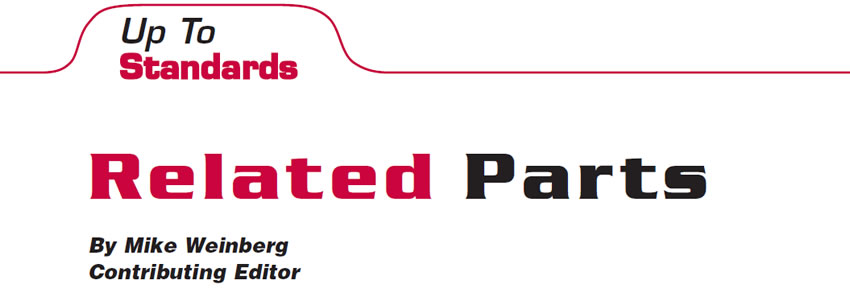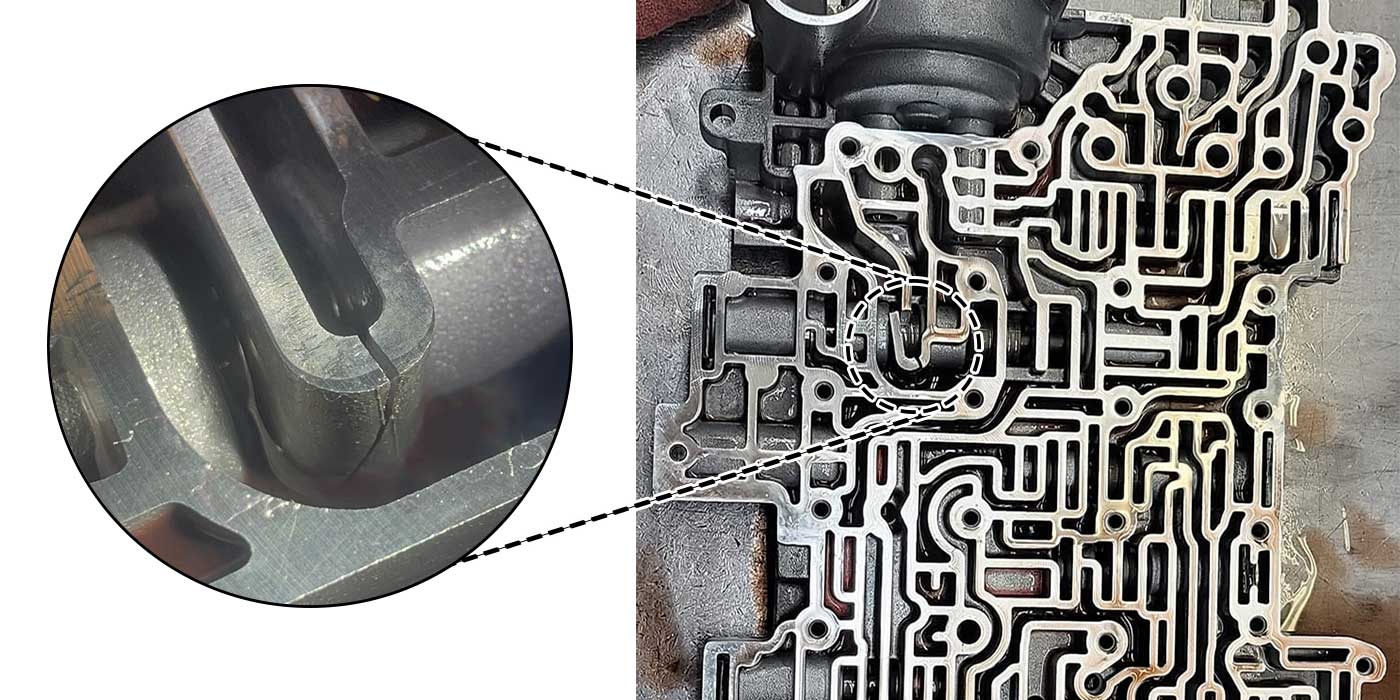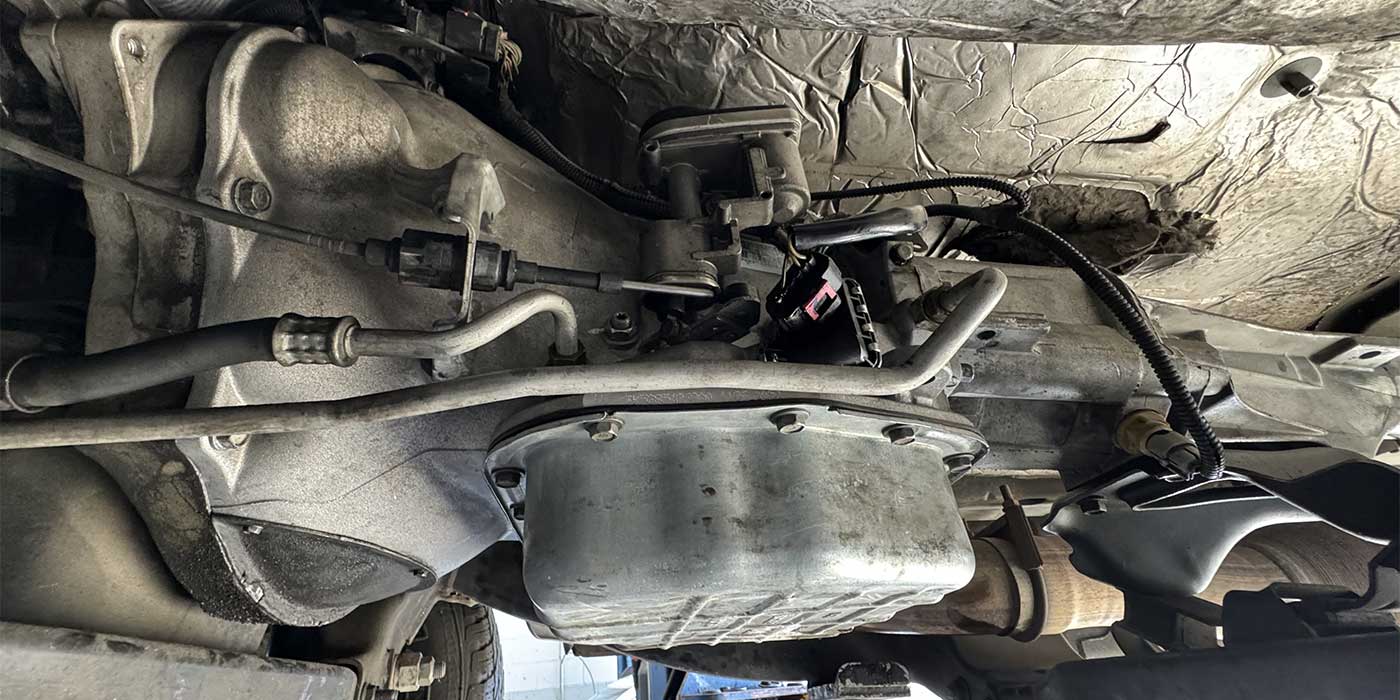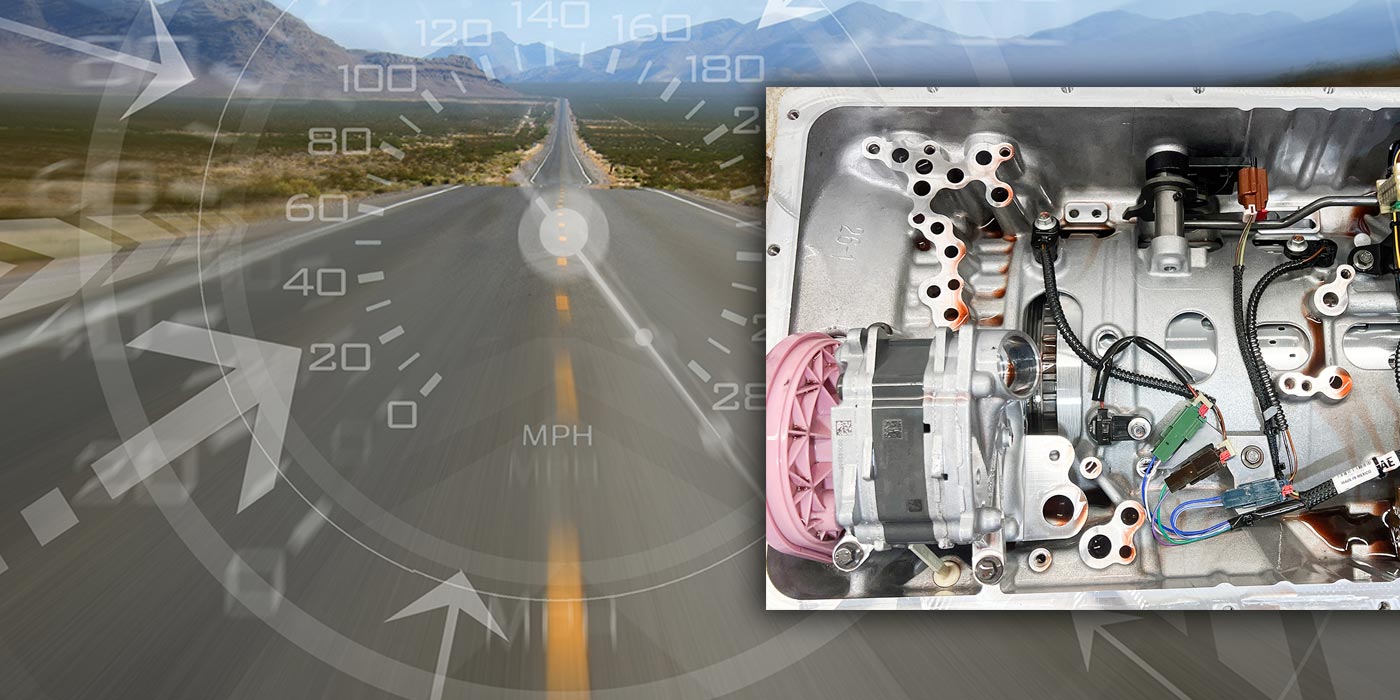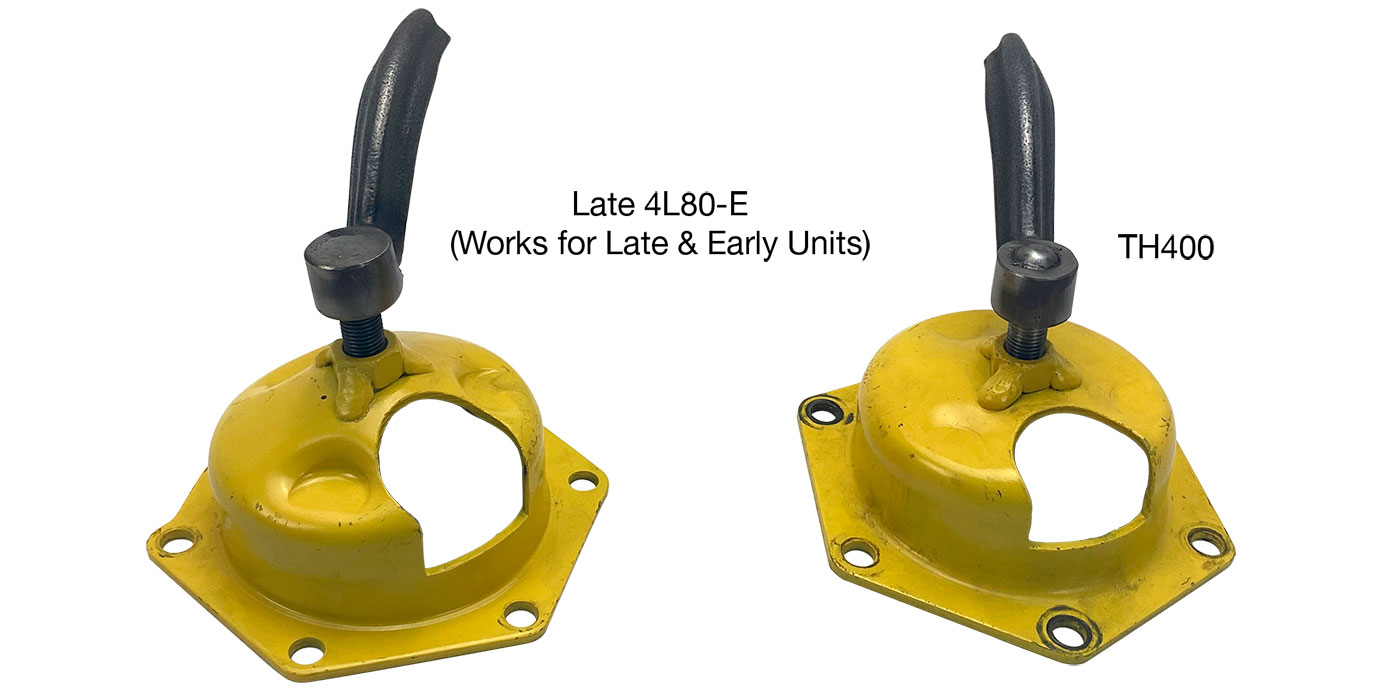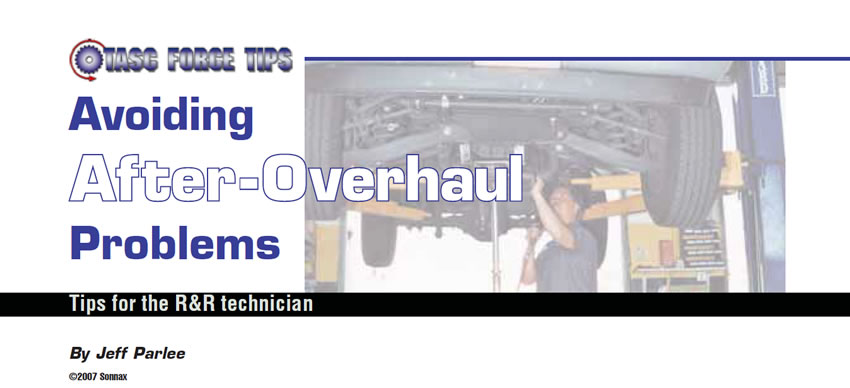
TASC Force Tips
- Author: Jeff Parlee
Tips for the R&R technician
Being an R&R technician is challenging work. Even worse, you can make the job harder with one little slip or missed step. All it takes is forgetting to disconnect a wiring harness before dropping the transaxle: Before you know it, the transmission jack is coming down but the transaxle is suspended in mid-air by the harness. Once the transaxle is repaired and installed in the car, you have to diagnose and repair some new electrical problems that were not there before the rebuild. You can avoid this mistake and many others by new technicians by providing them with just a little training and a basic checklist of things that have to be done during every removal and installation of a transmission.
Many times a shop will hire a new R&R technician who has little or no experience with transmissions. Then they ask that technician to perform the job without even the most-basic training. This usually happens when the shop is very busy and can least afford to have these extra problems crop up. Catch 22, isn’t it? The following is a list of things that should be on your checklist and why they are important.
On most vehicles the battery should be disconnected before removing the transmission. Always be sure the key is in the off position before disconnecting the battery, to avoid computer damage. Keep in mind that the adaptive memory in the computers will be lost without a memory saver. Always disconnect the ground-side cable first.
Disconnect electrical connectors and mark for reassembly where needed. Some vehicles use the same type of connector for more than one electrical component. On many KM units, the solenoid connector and the pulse-generator connector use identical connectors and can easily be plugged into the wrong place. When disconnecting electrical connectors, be careful not to damage the retaining clip, and examine the male and female ends of the connectors for corrosion or other damage. Be sure that the wiring harness is disconnected from any routing clips and retainers. When disconnecting an electrical connector always pull on the connector, not the wires.
Double-check your work to be sure that all linkage, wiring, cables, mounts, cooler lines, converter bolts/nuts and axles have been removed and are out of the way. Be sure the engine-support fixture is in place if needed.
On rear-wheel-drive vehicles, always mark the driveshaft and differential yoke so they can be reassembled exactly as they were. Many driveshafts are phased, meaning that you can cause driveline vibrations if they’re not installed correctly.
On front-wheel-drive vehicles, never allow the weight of the vehicle to rest on the wheels once the drive axle has been removed from the wheel hub. The axle and axle nut hold together and put a preload on the wheel bearing. Without the axle installed in the bearing, it will become damaged and need replacement if the wheel bearing is loaded in any way.
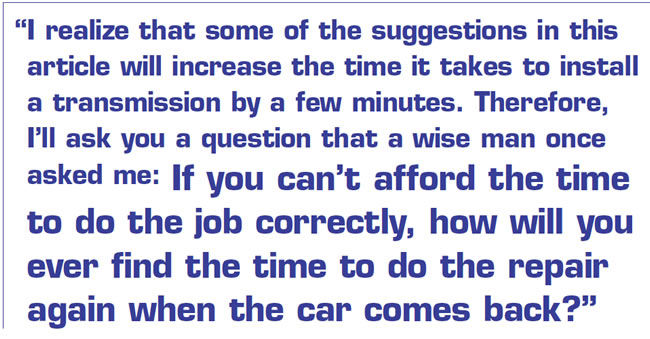
Always use a line wrench, sometimes called a flare-nut wrench, to loosen and tighten cooler-line nuts. Do not use an open-end or adjustable wrench on a cooler line or the fitting it threads into. An open-end-type wrench can round the cooler-line nut and fitting.
Once the transmission is out, check the cooler lines for kinks, rub marks or leaks, and flush the cooler. When possible, the cooler should be flushed both ways for as long as it takes to get it clean. Our experience has shown that flushing the cooler in the direction of flow for a half hour, then back-flushing for a half hour, and finally flushing again in the direction of flow gives the best results. Using a hot flusher with the capability of pulsing the flow works best. Keep in mind that not all coolers can be cleaned.
Always check cooler flow after the vehicle has been warmed to operating temperature. Cooler flow for a transmission with 5/16-inch cooler lines should be a minimum of one quart of fluid in 20 seconds. Most transmissions will produce a quart in 10 seconds when working correctly. Do not rely on the cooler flusher to determine the cooler flow. The cooler flusher puts more pressure to the cooler than the transmission does, and many times a cooler will start to clog again after being flushed. This happens because the flusher opens up a small area of the cooler and when the new transmission fluid starts to circulate in the cooler at the lower pressure, it allows the dirt to be rearranged so that the cooler becomes restricted again. This cooler must be replaced to protect you from a very expensive comeback!
Many Nissans, like the Pathfinder with the RE4RO1A transmission, have a fin-type cooler that cannot be flushed. It must be replaced. I would highly recommend installing an inline transmission filter on the return cooler line for any unit that has contaminated the cooler. When the vehicle returns for the two-week checkup, replace the inline filter with a new one. This is insurance for your transmission and shows the customer that you are protecting their investment –a great tool for building customer trust! Speaking of inline filters, some vehicles – Subaru and Ford, for example – have inline filters from the factory. You must bypass the inline filter to flush the cooler and lines, and then replace the filter with a new one.
Check the flex plate for cracks and damage to the teeth on the ring gear. Check the starter drive for damage. If the ring gear is damaged, so is the starter drive. On some Ford models, there is a spacer between the flex plate and the crankshaft that often cracks. Remove the spacer and check it carefully. If it’s damaged, replace it! Always torque the bolts attaching the flex plate to the crankshaft using the proper sequence, or if none is given tighten in a star pattern. Using an impact gun to tighten these bolts can stretch them and cause them to break and allow the end of the crankshaft to distort enough for the rear main engine oil seal to leak. Check that all dowel pins for aligning the bellhousing to the engine are in place. Missing dowel pins can cause pump-bushing failure, converter-hub failure, damage to the flex plate, pump seal leaks and possible pump damage on some transmissions.
Before installing a remanufactured converter, check that the converter pilot fits into the end of the crankshaft without binding. On some converters, you may need to use sandpaper to remove the paint from the pilot and lube the pilot to ensure that it moves freely in and out of the crankshaft. The pilot is used to support the weight of the converter and keep the front of the torque converter aligned with the center of the crankshaft. Some engines and converters use a ring or sleeve between the torque-converter pilot and the inside of the crankshaft, and the ring or sleeve may have been stuck to the old converter. Always make sure that the pilot is not loose in the end of the crankshaft. A loose fit would indicate a missing sleeve or ring. Without this ring to center the pilot in the end of the crankshaft, the converter will not be spinning on the centerline of the crankshaft, causing vibrations at the least. Flex-plate damage, pump damage or front-seal leaks also are possible.
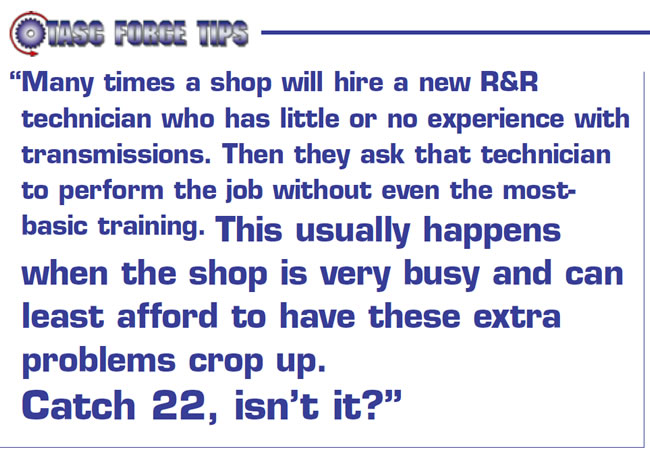
If your converter-to-flex-plate fasteners are bolts, thread the bolts into the converter to be certain that the threads are not damaged and the bolts are not too long. The head of the bolt should touch the pad when finger tight. The bolts may have to be shortened on a grinder if they’re too long. During the torque-converter rebuilding process, the pads that the bolts thread into sometimes are cut down to true up the converter. This process allows for less thread depth for the bolt, causing the bolts to push into the front cover and make a dimple in the metal when tightened. The dimple will tear up the clutch lining inside the torque converter. If your converter-to-flex-plate fasteners are nuts, test them on the new converter, too. It’s a lot easier to fix a thread problem with the torque converter out of the car.
Before jacking the transmission into place, take a moment to make sure that the wires and linkage are organized. The wires should be routed close to where they will be connected eventually, but away from the mating surface between the bellhousing and engine. Make sure that the linkage is in a place where it will not impede the transmission installation. You don’t need the transmission flipped off the jack or the linkage bent.
When installing the torque converter into the bellhousing, make sure it is seated fully onto the shafts or into the pump. Never use the bellhousing-to-engine bolts to draw in the transmission! The bellhousing should push flush against the engine, by hand, and the torque converter should move if it is correctly seated in the bellhousing. Typically, there will be a clearance of 1/8 to 3/16 inch between the converter and the flex plate once the bellhousing is seated against the engine.
Speaking of flex plates, the Ford 5R55N, 5R55S and 5R55W torque converters have a plate that bolts to the converter and must be aligned with a special tool (# 307-403). After aligning the plate and tightening the nuts that hold it to the torque converter, remove the tool and then the converter/plate assembly is ready to be installed into the flex plate. Failure to use this alignment tool can result in vibrations and flex-plate failure. The special tool is available from Ford or an aftermarket supplier.
Always pull up on the converter-to-flex-plate bolts evenly. Do not be tempted to hit the first bolt with an impact gun to pull the converter to the flex plate. Sooner or later that practice will cause flex-plate, pump or converter problems. Be sure that the torque converter is contacting the flex plate at all contact points before completely tightening any of the bolts or nuts.
When installing the transmission, always torque the axle nuts to specification to ensure long bearing life. Always torque wheel lug nuts to avoid warping the rotors and causing brake problems. Overtightening the wheel lugs with an impact gun can stretch the studs, causing them to fail prematurely.
Double-check your work! Always check the electrical connectors to be sure they are fully seated. Check the routing of all the wiring harnesses, making sure they are not rubbing against any sharp edges, near any hot exhaust pipes, too close to moving parts or pinched between the engine and transmission.
Make a habit of ensuring that the ignition switch is in the off or lock position before reconnecting the battery. Computers are extremely sensitive to voltage spikes and can be damaged easily if the ignition switch is in the on position when you reconnect the battery.
Check the cooler-line routing to be sure that the lines are not rubbing against anything or hanging too low. Most cooler lines have brackets and clips to secure them in the correct locations; use them.
Most transmissions are filled through the dipstick tube. If your transmission does not have a dipstick tube, follow the fill-and-check instructions in the manual. Do not assume that the big bolt on the side of the transmission is for filling it with ATF. Many newer transaxles have a large bolt that looks like a good filling spot, but it is a band anchor bolt. Removing the band anchor bolt allows the band to spin out of position, and the unit must be removed and disassembled to put the band back in the correct position.
Do not install the transmission fluid until you confirm it is the correct fluid for the vehicle and transmission you are working on! Many transmissions now require special fluids to perform correctly. An incorrect fluid can cause slips and/or chatters, set gear-ratio and lockup codes, or create premature transmission failure, transmission overheating and sometimes leaking from the vent because of expansion from foaming or overheating.
Keep in mind that a good checklist will help you reduce costly mistakes, especially when you are busy or get pulled away from a job. Checklists also will help the shop to get paid for the little repairs and parts that get forgotten until after the price quote has been given. Write down any repairs or damaged parts on the checklist and attach the checklist to the work order. Now these repairs and parts can be included in the price quote.
I realize that some of the suggestions in this article will increase the time it takes to install a transmission by a few minutes. Therefore, I’ll ask you a question that a wise man once asked me: If you can’t afford the time to do the job correctly, how will you ever find the time to do the repair again when the car comes back? My answer was to find the time to do it correctly so that I had to do it only once.

Jeff Parlee is director of product support for ValveBody Xpress and a member of the TASC Force (Technical Automotive Specialties Committee), a group of recognized industry technical specialists, transmission rebuilders and Sonnax Industries Inc. technicians. ©2008 Sonnax

